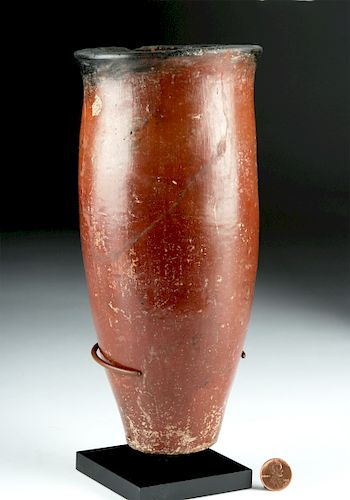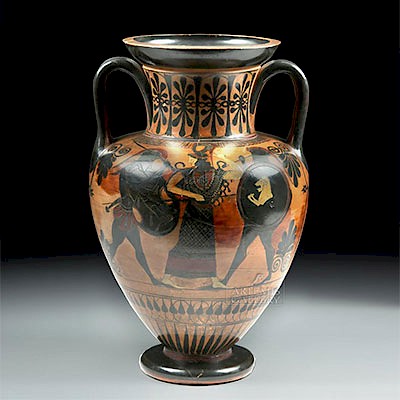Tall Egyptian Naqada Blacktop Pottery Vessel
Lot 2
About Seller
Artemis Fine Arts
686 S Taylor Ave, Ste 106
Louisville, CO 80027
United States
Selling antiquities, ancient and ethnographic art online since 1993, Artemis Gallery specializes in Classical Antiquities (Egyptian, Greek, Roman, Near Eastern), Asian, Pre-Columbian, African / Tribal / Oceanographic art. Our extensive inventory includes pottery, stone, metal, wood, glass and textil...Read more
Estimate:
$4,000 - $6,000
Absentee vs Live bid
Two ways to bid:
- Leave a max absentee bid and the platform will bid on your behalf up to your maximum bid during the live auction.
- Bid live during the auction and your bids will be submitted real-time to the auctioneer.
Bid Increments
| Price | Bid Increment |
|---|---|
| $0 | $25 |
| $300 | $50 |
| $1,000 | $100 |
| $2,000 | $250 |
| $5,000 | $500 |
| $10,000 | $1,000 |
| $20,000 | $2,500 |
| $50,000 | $5,000 |
| $100,000 | $10,000 |
| $200,000 | $20,000 |
About Auction
By Artemis Fine Arts
Oct 11, 2018
Set Reminder
2018-10-11 10:00:00
2018-10-11 10:00:00
America/New_York
Bidsquare
Bidsquare : Exceptional Antiquities | Ethnographic Art
https://www.bidsquare.com/auctions/artemis-gallery/exceptional-antiquities-ethnographic-art-3500
An important one-day auction featuring museum-worthy examples of classical antiquities, ancient and ethnographic art from cultures encompassing the globe. Artemis Fine Arts info@artemisgallery.com
An important one-day auction featuring museum-worthy examples of classical antiquities, ancient and ethnographic art from cultures encompassing the globe. Artemis Fine Arts info@artemisgallery.com
- Lot Description
Ancient Egypt, Predynastic Period, late Naqada I to Naqada II, ca. 3700 to 3400 BCE. A gorgeous coil-formed Nile silt pottery vase with a highly-burnished exterior surface covered in a deep, earthy iron-oxide slip. The conical body rests atop a planar base, its walls gradually tapering to a thin, flared rim and a deep interior cavity. A small portion of the rim's exterior surface is colored black, comprised of carbon deposits formed by subjecting them extensively to thick clouds of smoke in an oxygen-deprived environment. Black-top vessels originally rose to popularity during the early Naqada I, a culture which inhabited ancient Egypt during its predynastic period around 4000 BCE. The Naqada were first described by famed archaeologist William Flinders Petrie, however relatively little is known about them except that they were focused around the site of El-Amra in central Egypt, west of the Nile River. Custom museum-quality display stand included. Size: 4.375" W x 9.125" H (11.1 cm x 23.2 cm); 10" H (25.4 cm) on included custom stand.
Pre-Dynastic Egyptian black-top vessels were traditionally made from silt deposits taken from the Nile river due to their abundance in iron and silica. After the pot had dried but before it was fired, it would first be burnished and rubbed smooth with a small stone to create the pinstripe vertical striations still visible today. An iron-rich slip would then be applied just before firing; when placed in an oxygen-rich environment, the elevated temperatures would create the vessel's signature red-orange hue.
After the end of the Naqada III period around 3000 BCE, the use of Nile silt in pottery creations fell out of favor with the Predynastic Egyptians. This was due to the increase in the popularity of marl clay, a newly-discovered material for creating terracotta objects which was easier to shape and enabled firing at greater temperatures than the highly-porous silt. A few blacktop examples have been found from later Dynastic periods, however they were likely used solely for ritualistic and/or ceremonial purposes.
For a stylistically-similar example with a greater amount of black coloration, please see The British Museum, museum number EA30814: http://www.britishmuseum.org/research/collection_online/collection_object_details.aspx?objectId=109808&partId=1&searchText=Predynastic+AND+Egypt&page=1
A slightly-smaller yet stylistically-similar example hammered for $5,625 at Sotheby's, New York Antiquities Auction (December 12, 2013, lot 62): http://www.sothebys.com/en/auctions/ecatalogue/2013/antiquities-n09056/lot.62.html
Provenance: private East Coast, USA collection; ex-Richard Wagner collection, Cape Cod, Massachusetts, USA, acquired in the 1970s
All items legal to buy/sell under U.S. Statute covering cultural patrimony Code 2600, CHAPTER 14, and are guaranteed to be as described or your money back.
A Certificate of Authenticity will accompany all winning bids.
We ship worldwide and handle all shipping in-house for your convenience.
#139450Vessel professionally repaired from multiple large pieces with some areas of restoration as well as resurfacing, overpainting, and light adhesive residue along break lines. Surface wear and abrasions commensurate with age, small losses to rim, body, and base, with some fading to red and black coloration, and small pecking marks along base. Nice earthen deposits throughout.Condition
- Shipping Info
-
All shipping is handled in-house for your convenience. Your invoice from Artemis Gallery will include shipping calculation instructions. If in doubt, please inquire BEFORE bidding for estimated shipping costs for individual items.
-
- Buyer's Premium



 EUR
EUR CAD
CAD AUD
AUD GBP
GBP MXN
MXN HKD
HKD CNY
CNY MYR
MYR SEK
SEK SGD
SGD CHF
CHF THB
THB














